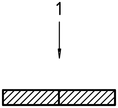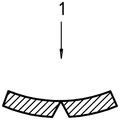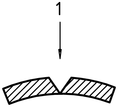ISO 6603-1-2000 “Plastik – Penentuan perilaku dampak tusukan plastik kaku – Bagian 1: Pengujian dampak non-instrumental”
perkenalan
ISO (Organisasi Internasional untuk Standardisasi) adalah aliansi global badan standar nasional (badan anggota ISO). Pengembangan standar internasional biasanya dilakukan melalui komite teknis ISO. Setiap lembaga anggota yang tertarik pada suatu mata pelajaran yang telah dibentuk komite teknisnya berhak untuk diwakili dalam komite tersebut. Organisasi pemerintah dan non-pemerintah internasional yang bekerja sama dengan ISO juga terlibat dalam pekerjaan ini. ISO bekerja sama dengan Komisi Elektroteknik Internasional (IEC) tentang segala hal standardisasi kelistrikan.
Standar internasional disusun sesuai dengan aturan yang diberikan di Bagian 3 dari Petunjuk ISO/IEC.
Rancangan standar internasional yang diadopsi oleh Komite Teknis akan diedarkan ke badan-badan anggota untuk pemungutan suara. Publikasi sebagai standar internasional memerlukan persetujuan paling sedikit 75% dari lembaga-lembaga anggota.
Please note that some elements of this part of ISO 6603 May be the subject of a patent right. ISO tidak bertanggung jawab untuk mengidentifikasi salah satu atau semua paten tersebut.
ISO standar internasional 6603-1 was developed by the Technical Committee ISO/TC61, Plastik, Subkomite SC 2, Mechanical Properties.
ISO 6603-1-2000 “Plastik – Penentuan perilaku dampak tusukan plastik kaku – Bagian 1: Pengujian dampak non-instrumental”
Edisi kedua membatalkan dan menggantikan edisi pertama yang direvisi secara teknis (ISO 6603-1:1985).
ISO 6603 terdiri dari bagian-bagian berikut, under the general heading Plastics – Penentuan perilaku dampak tusukan plastik kaku:
– Bagian 1: Pengujian dampak non-instrumental
– Bagian 2: Instrumented impact testing
Appendix A of this part of ISO 6603 is for information purposes only.
1 Jangkauan
This standard specifies a method for determining, under specified conditions, the puncture impact properties of rigid plastics in the form of flat specimens, such as disks or squares. The sample can be molded directly, cut from the sheet or removed from the finished product. Different types of samples and test conditions are defined.
ISO 6603-1-2000 “Plastik – Penentuan perilaku dampak tusukan plastik kaku – Bagian 1: Pengujian dampak non-instrumental”
These drop dart methods are used to study the behavior of plastic films or molds under the impact of a firing pin perpendicular to the specimen plane.
Bagian dari ISO ini 6603 can be used if it is sufficient to characterize the impact behavior of plastics by an impact failure energy threshold based on many samples. If a force-deflection or force-time plot recorded at a nominal constant firing pin speed is necessary to characterize impact behavior in detail, ISO 6603-2 digunakan.
These test methods are suitable for specimens with thicknesses between 1 mm and 4 mm.
Note For thicknesses less than 1 mm, ISO 7765 is recommended. If the equipment is suitable, it is possible to test thicknesses greater than 4 mm, but this test falls outside the scope of ISO 6603-1 dan ISO 6603-2.
These methods are suitable for the following types of materials:
Rigid thermoplastic molding and extrusion materials, including filled, unfilled and reinforced compounds and sheets;
– Rigid thermosetting molding and extrusion materials, including filling and reinforcing compounds, sheets and laminates;
ISO 6603-1-2000 “Plastik – Penentuan perilaku dampak tusukan plastik kaku – Bagian 1: Pengujian dampak non-instrumental”
Fiber-reinforced thermoset and thermoplastic composites, including unidirectional or non-unidirectional reinforcement materials, such as MATS, woven fabrics, woven roving, cut strands, combined and mixed reinforcement materials, roving, milled fibers and sheets made from pre-impregnated materials (prepregs).
These methods are also applicable to samples molded or machined from finished products, laminates and extruded or cast plates.
The test results are comparable only when the preparation conditions, size and surface of the sample and the test conditions are the same. Secara khusus, the results determined on specimens of different thicknesses cannot be compared with each other (see Appendix E: – to ISO 6603-2). A comprehensive assessment of the impact stress response requires measurement of the impact velocity and temperature of different material variables, such as crystallinity and moisture content.
The impact behavior of the finished product cannot be predicted directly from this test, but samples can be taken from the finished product (see above) for testing by these methods.
Test data developed through these methods should not be used in design calculations. Namun, information on the typical behaviour of the material can be obtained by testing at different temperatures and impact velocities (see Annex D of ISO 6603-2: -), varying thickness (see Annex E of ISO 6603-2: -) and testing samples prepared under different conditions.
Bagian dari ISO ini 6603 describes two statistical test methods:
– Metode A: Staircase Method (Individual) (preferred)
In this method, a uniform energy increment is used during the test. After testing each sample, the energy is reduced or increased by uniform increments, depending on the observations (lulus atau gagal) of the previous test.
ISO 6603-1-2000 “Plastik – Penentuan perilaku dampak tusukan plastik kaku – Bagian 1: Pengujian dampak non-instrumental”
– Metode B: Group method (Opsional)
In this method, a continuous group of at least ten samples is tested. The impact failure energy is calculated statistically.
2 Acuan normatif
The following normative documents contain provisions that, dengan referensi di sini, merupakan ketentuan bagian ISO ini 6603. Untuk referensi bertanggal, any subsequent revisions or amendments to these publications will not apply. Namun, Parties to agreements based on this part of ISO 6603 are encouraged to investigate the possibility of applying new versions of the following normative documents. Untuk referensi tidak bertanggal, a new version of the standard-setting document referred to applies. ISO and IEC members maintain a register of currently valid international standards.
ISO 291:1997, Plastik. Adjust and test the standard atmosphere.
ISO 293:1986, Plastik. Compression forming sample of thermoplastic material.
ISO 294-3:1996, Plastik. Injection molding of thermoplastic material samples. Bagian 3: Small board.
ISO 295:1991, Plastik. Compression molding of thermosetting material samples.
ISO 1268:19741), Plastik – Preparation of glass fiber reinforced, resin bonded, low pressure laminates or panels for test purposes.
ISO 2818:1994, Plastik. The sample was prepared by machining.
ISO 7765-1:1988, plastic films and sheets. The impact resistance was determined by the free falling dart method. Bagian 1: Staircase method.
ISO 7765-2:1994, plastic films and sheets. The impact resistance was determined by the free fall dart method. Bagian 2: Instrumental puncture test.
ISO 6603-1-2000 “Plastik – Penentuan perilaku dampak tusukan plastik kaku – Bagian 1: Pengujian dampak non-instrumental”
3 Istilah dan definisi
Untuk keperluan bagian ISO ini 6603, istilah dan definisi berikut berlaku:
3.1 Ringkasan
3.1.1 Failure
Any visible breakage of the specimen surface
3.2 Failure standard terms
3.2.1 Crack
Any cracks that are visible to the naked eye and cannot penetrate the entire thickness of the material
Melihat: Angka 1
3.2.2 Broken
Any cracks throughout the entire thickness of the material
Melihat: Angka 2
3.2.3 Penetrasi
Failure of the firing pin to penetrate the entire thickness of the specimen
Melihat: Angka 3 B)
3.2.4 Grinding
Break the sample into two or more pieces
Melihat: Angka 3 A)
3.3 Impact failure items
3.3.150 % impact failure energy E50
The energy that causes 50% of the sample to fail, as defined in 3.1.1
3.3.250 % impact failure mass M50
The mass that causes 50% of the sample to fail at a given fall height, as defined in 3.1.1
3.3.350 % impact failure mass H50
50% impact failure height H50 uses the height at which a given falling mass causes 50% sample failure, as defined in 3.1.1
Angka 1 – Specimen sections damaged by “retak” [B) and c) after bending by hand
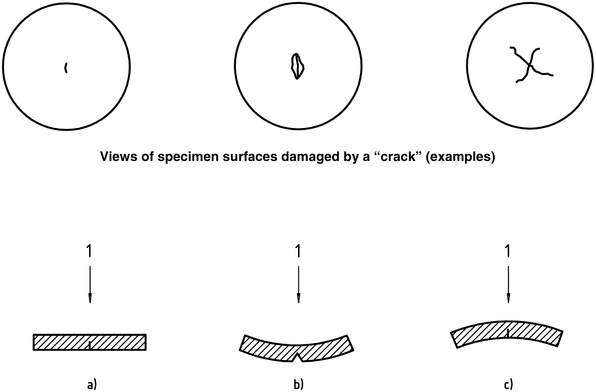
| 1 | Impact direction |
ISO 6603-1-2000 “Plastik – Penentuan perilaku dampak tusukan plastik kaku – Bagian 1: Pengujian dampak non-instrumental”
Angka 2 – Slices passed through the specimen are damaged by “breakage” [B) and c) after bending by hand
| A)
| B)
| C)
|
| 1 | Impact Direction |
Angka 3 – Examples of “broken” failures [A) Dan “penetrated” [B)
A)
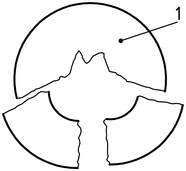
B)
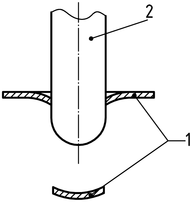
| 1 | Contoh |
| 2 | Darts with hemispherical heads |
Hanya bagian informasi standar yang bersifat publik. Untuk melihat konten selengkapnya, Anda perlu membeli standar melalui saluran resmi.

